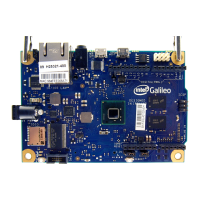Intel
®
Galileo Board—Communication and Programming
Intel
®
Galileo
Board User Guide March 2014
16 Order Number: 330237-001US
3.0 Communication and Programming
3.1 Communication
The Intel
®
Galileo Board has a number of facilities for communicating with a computer,
another Arduino board, or other microcontrollers.
UART
The board provides UART TTL (5 V/3.3 V) serial communication, which is available
on digital pin 0 (RX) and 1 (TX). In addition, a second UART provides RS-232
support and is connected via a 3.5 mm jack.
USB Client Ports
The USB Client ports allows for serial (CDC-ACM) communications over USB. This
provides a serial connection to the Serial Monitor or other applications on your
computer. It is also used to upload sketches to the board.
USB Host Port
The USB Host port allows the board to act as a USB Host for connected peripherals
such as mice, keyboards, and smartphones.
mini PCI Express* (mPCIe*)
The Intel
®
Galileo Board is the first Arduino board to provide a mini PCI Express*
(mPCIe*) slot. This slot allows full size and half size (with adapter) mPCIe*
modules to be connected to the board and also provides an additional USB Host
port via the mPCIe* slot. Any standard mPCIe* module can be connected and used
to provide applications such as WiFi, Bluetooth or Cellular connectivity. Initially, the
mPCie* slot provides support for the WiFi Library. For additional information, see
the Intel
®
Galileo Board Getting Started Guide ([GSG] in Table 4).
Ethernet RJ45
An Ethernet RJ45 Connector is provided to allow the board to connect to wired
networks. Full support of on-board Ethernet interface is fully supported and does
not require the use of the SPI interface like existing Arduino shields.
microSD card reader
The onboard microSD card reader is accessible through the Arduino SD Library.
The communication between the board and the SD card is provided by an
integrated SD controller and does not require the use of the SPI interface like other
Arduino boards. The native SD interface runs at up to 50 MHz depending on the
class of card used.
TWI/I
2
C*
The Arduino software includes a Wire library to simplify use of the TWI/I
2
C* bus;
see the Arduino documentation for details.
SPI
For SPI communication, use the Arduino SPI library.

